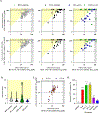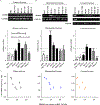Exploiting the HSP60/10 chaperonin system as a chemotherapeutic target for colorectal cancer
- PMID: 33971488
- PMCID: PMC8194340
- DOI: 10.1016/j.bmc.2021.116129
Exploiting the HSP60/10 chaperonin system as a chemotherapeutic target for colorectal cancer
Abstract
Over the past few decades, an increasing variety of molecular chaperones have been investigated for their role in tumorigenesis and as potential chemotherapeutic targets; however, the 60 kDa Heat Shock Protein (HSP60), along with its HSP10 co-chaperone, have received little attention in this regard. In the present study, we investigated two series of our previously developed inhibitors of the bacterial homolog of HSP60/10, called GroEL/ES, for their selective cytotoxicity to cancerous over non-cancerous colorectal cells. We further developed a third "hybrid" series of analogs to identify new candidates with superior properties than the two parent scaffolds. Using a series of well-established HSP60/10 biochemical screens and cell-viability assays, we identified 24 inhibitors (14%) that exhibited > 3-fold selectivity for targeting colorectal cancer over non-cancerous cells. Notably, cell viability EC50 results correlated with the relative expression of HSP60 in the mitochondria, suggesting a potential for this HSP60-targeting chemotherapeutic strategy as emerging evidence indicates that HSP60 is up-regulated in colorectal cancer tumors. Further examination of five lead candidates indicated their ability to inhibit the clonogenicity and migration of colorectal cancer cells. These promising results are the most thorough analysis and first reported instance of HSP60/10 inhibitors being able to selectively target colorectal cancer cells and highlight the potential of the HSP60/10 chaperonin system as a viable chemotherapeutic target.
Keywords: Chaperonin; Chemotherapeutic; Colorectal cancer; GroEL; GroES; HSP10; HSP60; Molecular chaperone; Proteostasis; Small molecule inhibitors.
Copyright © 2021 Elsevier Ltd. All rights reserved.
Conflict of interest statement
Declaration of Competing Interest
The authors declare the following competing financial interest(s): S.M.J. and E.C. are co-founders of BioEL Inc, which was formed to commercialize GroEL/ES inhibitors, stemming from research conducted in their laboratories, for antibacterial applications.
Declaration of interests
The authors declare the following financial interests/personal relationships which may be considered as potential competing interests:
Figures








Similar articles
-
HSP60/10 chaperonin systems are inhibited by a variety of approved drugs, natural products, and known bioactive molecules.Bioorg Med Chem Lett. 2019 May 1;29(9):1106-1112. doi: 10.1016/j.bmcl.2019.02.028. Epub 2019 Feb 28. Bioorg Med Chem Lett. 2019. PMID: 30852084 Free PMC article.
-
Bis-aryl-α,β-unsaturated ketone (ABK) chaperonin inhibitors exhibit selective cytotoxicity to colorectal cancer cells that correlates with levels of aberrant HSP60 in the cytosol.Bioorg Med Chem. 2022 Dec 1;75:117072. doi: 10.1016/j.bmc.2022.117072. Epub 2022 Oct 30. Bioorg Med Chem. 2022. PMID: 36356534 Free PMC article.
-
GroEL/ES inhibitors as potential antibiotics.Bioorg Med Chem Lett. 2016 Jul 1;26(13):3127-3134. doi: 10.1016/j.bmcl.2016.04.089. Epub 2016 May 4. Bioorg Med Chem Lett. 2016. PMID: 27184767
-
Molecular chaperone GroEL/ES: unfolding and refolding processes.Biochemistry (Mosc). 2013 Dec;78(13):1405-14. doi: 10.1134/S0006297913130038. Biochemistry (Mosc). 2013. PMID: 24490731 Review.
-
HSP60 as a drug target.Curr Pharm Des. 2013;19(3):441-51. Curr Pharm Des. 2013. PMID: 22920899 Review.
Cited by
-
Exploring Novel Antibiotics by Targeting the GroEL/GroES Chaperonin System.ACS Pharmacol Transl Sci. 2024 Dec 11;8(1):10-20. doi: 10.1021/acsptsci.4c00397. eCollection 2025 Jan 10. ACS Pharmacol Transl Sci. 2024. PMID: 39816798 Review.
-
Discovery of a Tunable Heterocyclic Electrophile 4-Chloro-pyrazolopyridine That Defines a Unique Subset of Ligandable Cysteines.ACS Chem Biol. 2024 May 17;19(5):1082-1092. doi: 10.1021/acschembio.4c00025. Epub 2024 Apr 17. ACS Chem Biol. 2024. PMID: 38629450 Free PMC article.
-
Ins and Outs of Heat Shock Proteins in Colorectal Carcinoma: Its Role in Carcinogenesis and Therapeutic Perspectives.Cells. 2021 Oct 24;10(11):2862. doi: 10.3390/cells10112862. Cells. 2021. PMID: 34831085 Free PMC article. Review.
-
Targeting the mitochondrial unfolded protein response in cancer: opportunities and challenges.Trends Cancer. 2021 Dec;7(12):1050-1053. doi: 10.1016/j.trecan.2021.08.008. Epub 2021 Sep 24. Trends Cancer. 2021. PMID: 34580036 Free PMC article.
-
Clinicopathologic Significance of Heat Shock Protein 60 as a Survival Predictor in Colorectal Cancer.Cancers (Basel). 2023 Aug 11;15(16):4052. doi: 10.3390/cancers15164052. Cancers (Basel). 2023. PMID: 37627080 Free PMC article.
References
-
- Ferlay J; Ervik M; Lam F; Colombet M; Mery L; Pineros M; Znaor A; Soerjomataram I; Bray F Cancer Today (powered by GLOBOCAN 2018) http://publications.iarc.fr/Databases/Iarc-Cancerbases/Cancer-Today-Powe... (accessed Jul 11, 2019).
-
- Howlander N; Noone AM; Krapcho M; Miller D; Brest A; Yu M; Ruhl J; Tatalovich Z; Mariotto A; Lewis DR; et al. SEER Cancer Statistics Review 1975–2016. Natl. Cancer Institute. 2019, https://seer.cancer.gov/csr/1975_2016/.
Publication types
MeSH terms
Substances
Grants and funding
LinkOut - more resources
Full Text Sources
Other Literature Sources
Chemical Information
Medical
Research Materials
Miscellaneous

